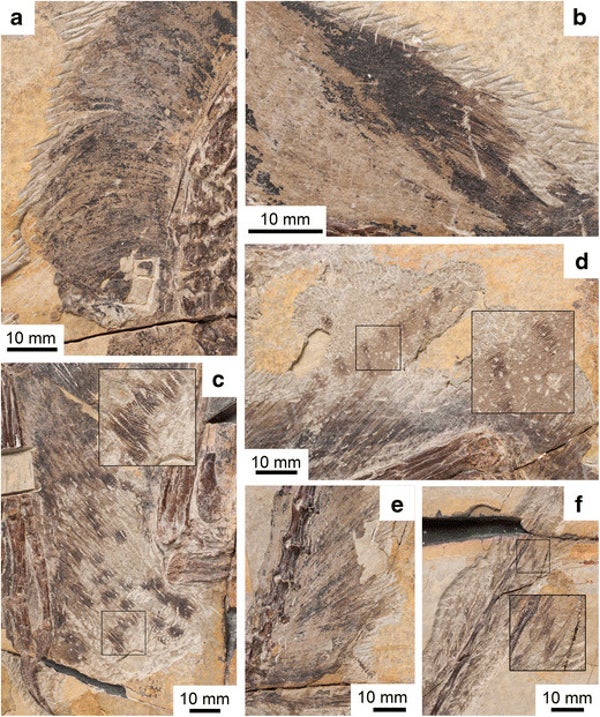This article was published in Scientific American’s former blog network and reflects the views of the author, not necessarily those of Scientific American
Feathers aren't just for flight. It can be easy to forget that.
The resilient, unique biological structures are what allowed dinosaurs to take to the air, after all, and drawing backwards from a chickadee to Archaeopteryx and deeper still, it would be only be natural to highlight the evolution of feathers' aerodynamic capabilities. Yet even from our living avian dinosaurs we know that feathers provide insulation, help birds to put on garishly colorful displays, and, with some flapping, allow their owners to better run up inclines, among other things. On top of all that, a newly-discovered dinosaur offers another reminder that there's more to feathers than flight.
Described by paleontologist Ulysee Lefèvre and colleagues, the fluffy fossil is among the latest to come out of the roughly 160 million year old Chinese deposits that have already yielded dozens of exquisitely-preserved dinosaurs. They've named it Serikornis - the silk bird - even though it's not technically a bird but one of the flightless feathered dinosaurs that clusters near the origin of avians in the bigger evolutionary tree. It's that position, in conjunction with the dinosaur's plumage, that makes it stand out.
Serikornis didn't just have one feather type. The feathers of the neck, for example, are similar to the wispy bundles found in other dinosaurs like Sinornithosaurus, while the arms have a mess of "short, slender, symmetrical, and poorly differentiated feathers" similar to those of Anchiornis. And on its hindlimbs, Serikornis has both fuzz and long pennaceous feathers like those of Microraptor. That's what makes this new dinosaur particularly significant.
Serikornis wasn't a flier. Its bones, as well as its feathers, indicate a terrestrial mode of life. Yet it has leg feathers that are often associated with the evolution of flight - a hypothesis that one line of feathered dinosaurs went through a four-winged gliding phase on the way to powered flight, embodied by Microraptor and its relatives. For a more archaic and grounded dinosaur to have leg feathers, then, indicates that long leg feathers evolved in a terrestrial context - perhaps for displays, Lefèvre and coauthors suggest - before being inherited by increasingly arboreal and aerodynamic dinosaurs. Life on the ground opened the possibility flight.
On supporting science journalism
If you're enjoying this article, consider supporting our award-winning journalism by subscribing. By purchasing a subscription you are helping to ensure the future of impactful stories about the discoveries and ideas shaping our world today.

The integument of Serikornis. Credit: Lefevre et al 2017
Fossil Facts
Name: Serikornis sungei
Meaning: Serikornis means "silk bird", while sungei honors paleontologist Sun Ge.
Age: Jurassic, around 160 million years ago.
Where in the world?: Linglongta, China.
What sort of organism?: A paravian dinosaur.
How much of the organism’s is known?: A single, articulated skeleton with feathers.
Reference:
Lefèvre, U., Cau, A., Cincotta, A., Hu, D., Chinsamy, A., Escuillie, F., Godefroit, P. 2017. A new Jurassic theropod from China documents a transitional step in the macrostructure of feathers. The Science of Nature. doi: 10.1007/s00114-017-1496-y
Previous Paleo Profiles:
The Light-Footed Lizard The Maoming Cat Knight’s Egyptian Bat The La Luna Snake The Rio do Rasto Tooth Bob Weir's Otter Egypt's Canine Beast The Vastan Mine Tapir Pangu's Wing The Dawn Megamouth The Genga Lizard The Micro Lion The Mystery Titanosaur The Echo Hunter The Lo Hueco Titan The Three-Branched Cicada The Monster of Minden The Pig-Footed Bandicoot Hayden's Rattlesnake Demon The Evasive Ostrich Seer The Paradoxical Mega Shark The Tiny Beardogs The Armored Fish King North America's Pangolin The Invisible-Tusked Elephant The Mud Dragon The Spike-Toothed Salmon The Dream Coast Crocodile Buriol's Robber Ozimek's Flyer The Northern Naustoceratopsian The High Arctic Flyer The Tomatillo From the End of the World The Short-Faced Hyena The Mighty Traveler from Egg Mountain Keilhau's Ichthyosaur Mexico's Ancient Horned Face Mauricio Fernández's Plesiosaur New Zealand's Giant Dawn Penguin The Orange Sea Lion Mongolia's Ginkgo Cousin The Geni River Frog Isabel Berry's Dinosaur The Whale Caiman The Moab Lizard Yang Zhongjian's Lizard The Little Anubis The Shuangbai Lizard The Wyvern Dinosaur The "Need Helmet" Dinosaur The Jianianhua Dragon The Liaoning Hunter The Dalian Lizard Crompton's Aleodon Jenkins' Amphibian Serpent From the Chinle The Large Ancestor Lizard The Crown Tooth Currie's Alberta Hunter The Elephant Bird Mimic The Crested Thief The Hiding Hunter The Horned Lizard